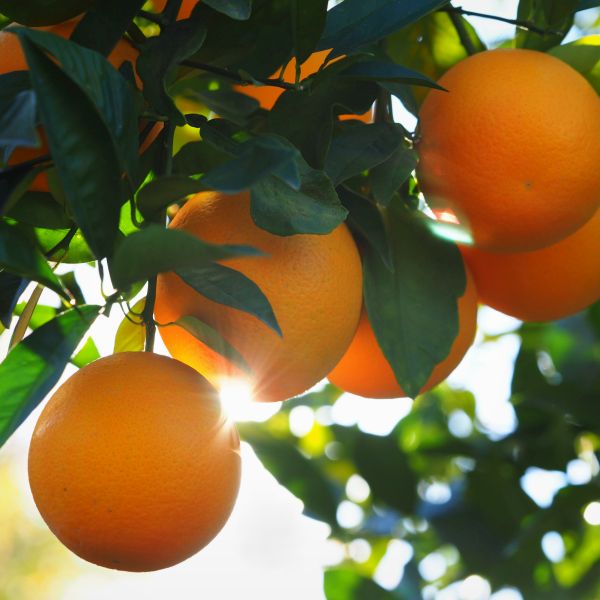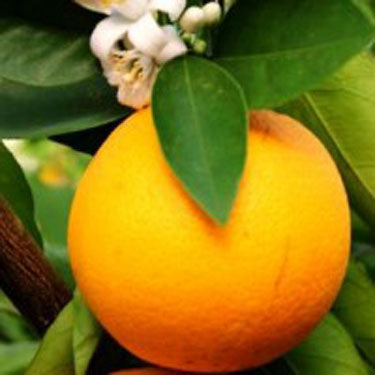Valencia Orange Tree
Citrus x 'Valencia'
- Stay Protected with Plant Sentry ™
Valencia Orange Tree - #3 Container is backordered and will ship as soon as it is back in stock.
Plant Sentry™
Plant Sentry™

Plant Sentry™ Protected
Your order is protected by our compliance system that:
- Prevents restricted plants from shipping to your state
- Ensures plants meet your state's agricultural requirements
- Protects gardens from invasive pests and diseases
Delivery and Shipping
Delivery and Shipping
Delivery and Shipping
Fast, Safe Plant Delivery
Ships in 3-4 business days • Tracking provided • Weather protected
| Under $50 | $9.99 |
| $50 - $99.99 | $14.99 |
| $100 - $149.99 | $16.99 |
| $150+ | $24.99 |
✓ Zone-specific timing • ✓ Professional packaging • ✓ Health guarantee
Understanding Plant Options
Nature Hills offers plants in two main formats:
- Container Plants: Grown in pots with soil, sized by container volume and plant age
- Bare Root Plants: Dormant plants without soil, sized by height measurements
Container Plant Sizes
Container sizes indicate plant age and growing capacity rather than liquid volume equivalents. Our containers follow industry-standard nursery "trade gallon" specifications, which differ from standard liquid gallon measurements.
Young Plants (6 months to 18 months old)
| Container Size | Actual Volume | Metric Equivalent |
|---|---|---|
| 2" x 2" x 3" | 0.18 - 0.21 dry quarts | 0.20 - 0.23 dry liters |
| 4" Container | 0.31 - 0.87 dry quarts | 0.35 - 0.96 dry liters |
| 4.5" Container | 0.65 dry quarts | 0.72 dry liters |
| 6" Container | 1.4 dry quarts | 1.59 dry liters |
| 1 Quart | 1 dry quart | 1.1 dry liters |
| 5.5" Container | 1.89 dry quarts | 2.08 dry liters |
Established Plants (18 months to 2.5 years old)
| Container Size | Actual Volume | Metric Equivalent |
|---|---|---|
| 2 Quart | 2 dry quarts | 2.2 dry liters |
| #1 Container | 2.26 - 3.73 dry quarts | 2.49 - 4.11 dry liters |
| 5" x 5" x 12" | 3.5 - 4.3 dry quarts | 3.85 - 4.74 dry liters |
Mature Plants (2-4 years old)
| Container Size | Actual Volume | Metric Equivalent |
|---|---|---|
| #2 Container | 1.19 - 1.76 dry gallons | 5.24 - 7.75 dry liters |
| #3 Container | 2.15 - 2.76 dry gallons | 8.14 - 12.16 dry liters |
Large Plants (3-5 years old)
| Container Size | Actual Volume | Metric Equivalent |
|---|---|---|
| #5 Container | 2.92 - 4.62 dry gallons | 12.86 - 20.35 dry liters |
| #6 Container | 5.25 - 6.01 dry gallons | 23.12 - 26.42 dry liters |
| #7 Container | 5.98 - 6.53 dry gallons | 26.34 - 28.76 dry liters |
Bare Root Plants
Bare root plants are sold by height from the root system to the top of the plant. Plants may exceed minimum height requirements.
Common Sizes:
- Trees: 1 foot, 2 feet, 3 feet, 4 feet, 5 feet, 6 feet
- Shrubs & Perennials: 1 foot, 18 inches, 2 feet
Important Notes
Container Volume Specifications
- Trade Gallon Standard: Our containers follow industry-standard "trade gallon" specifications established by the American National Standards Institute (ANSI Z60.1) for nursery stock
- Volume Variations: Actual soil volume may vary due to plant root systems and growing medium settlement
- Age Indicators: Container size primarily indicates plant age and maturity rather than liquid volume equivalents
Growing Conditions
- Plant size can vary based on variety and growing conditions
- Container size helps indicate plant maturity and establishment level
- Larger containers generally mean more established root systems and faster landscape establishment
Seasonal Availability
- Bare root plants are available seasonally when dormant
- Container plants are available throughout the growing season
- Specific varieties may have limited availability in certain sizes
Questions?
For questions about specific plant sizes or availability, please contact our plant experts who can help you choose the right size for your landscape needs.
Plant Highlights
Valencia Orange Tree highlights at a glance!
-
Botanical Name
-
Brand
-
Growth RateModerate
-
Mature Height
-
Mature Width
-
Leaf Color
-
Flower Color
-
Pollinator FriendlyYes
-
Pollinator Required
-
Bloom PeriodLate Spring
-
FragrantYes
Characteristics
Where To Plant
When To Prune
- Late Spring
Water & Moisture Needs
- Moderate
Sunlight Needs
Soil Needs
- Well drained

Growing Zones
Nothing quite quenches your thirst like a cool glass of orange juice made from Valencia oranges. This Citrus Fruit traces its roots back to the very beginning of the United States' Citrus-growing history and continues to be a staple in orange groves across the U.S. today.
Valencia Orange Tree's (Citrus x 'Valencia') sweet, succulent flavor is valued for more than just juicing. It's also a favorite orange to snack on due to its size, color, and delicious taste. As an added bonus, this breed of orange has very few seeds and is a breeze to peel, a trait that comes in handy when you're craving sweets and have to eat on the go.
The tree itself that the fruit grows on is a compact evergreen with glossy oval leaves that maintain their color all year long. Lovely white blossoms bloom on the tree during the spring months, filling your property with a sweet, tantalizing fragrance and attract pollinators. Blossoms transform into fruit from late spring into late fall and early winter.
Planting and Application:
In addition to being perfect for juicing, Valencia Oranges are also ideal for use in fruit salads, orange bread and other citrus desserts. Zest the peel for added zing when frosting rolls. You'll love finding ways to enjoy your Valencia Oranges.
Add to your home orchard and extend your growing season. Valencia Orange trees produce late in the season, so you'll enjoy fruit after all other Orange Trees are out of season. Enjoy this easy-to-grow, low-maintenance tree in your yard no matter what Zone you live in.
- Grow Indoors or Out
- Virtually Seedless & Easy to Peel
- Fragrant White Flowers
- Wonderful Orange for Juice & Snacking
- Easy to Grow!
#ProPlantTips for Care:
Valencia Oranges are among the easiest Citrus Trees to grow, whether you're an expert gardener or just starting to get your fingers dirty. It's a tough tree that manages to withstand poor soil, only requiring a moderate amount of moisture.
Citrus Trees are full sun plants, needing a minimum of 6 hours of direct sunlight a day. More sun means stronger growth, more flowers, and therefore more fruit! Preferring morning sun to dry the leaves of dew, these plants also like good air circulation to keep the foliage healthy.
Citrus need very well-drained soils that don't hold excess moisture. Mound up your planting area if you suspect poor drainage and container plants need deep planters with plenty of drainage holes. They also prefer their soil on the acidic side.
Let these plants dry out slightly between waterings and never allow their roots to sit in water. Plants in containers will not need much water during their dormant winter indoors. Citrus Trees will not tolerate standing water, so please don't overwater.
For lush plants with dark green leaves and plenty of fruit, set up a regular fertilizer routine, but use a light hand with fertilizers. For plants that aren't holding on to fruit, consider applying organic Citrus fertilizer monthly in spring and again in summer during the growing season. Feed planted Clementine container plants again right before you take them outside for the summer. Feed in-ground planted Clementines once during the dormant season.
Protecting Container Citrus From Cold
Although it's famous for growing in warmer regions, it can also thrive in colder areas as long as the tree is brought indoors prior to the first frost of winter.
If you're growing these tropical trees in the ground in the lowest of their favored growing zones, they need to be planted in a sheltered spot to avoid the worst of the chill. If a spot like that is unavailable, then you are better off planting in a large, deep container.
In borderline growing zones, begin slowly acclimating your tree indoors or into a protected location, eventually moving your tree inside in bright indirect sun for the winter if the temperatures in your area ever dip below that 40°F range. In spring, reverse this process and begin acclimating your tree to again be back out in the full sun all summer. This reduces stress and leaf drop.
- Full Sun
- Acidic Well-Drained Soil
- Provide Regular Fertilizer
- Prune After Fruiting
Valencia Orange Trees have been a juicy fan favorite for years! Order your own today for healthy snacking tomorrow from the citrus tree experts at NatureHills.com!
Terrific Sweet Orange for Juicing
Tracing its roots to the very beginning of citrus growing in the United States, the Valencia Orange continues to influence to this day. Even with the late 1800's challenge from the Washington Navel Orange, the Valencia has proven to be the select Orange for juicing - one of the most important usages of citrus.
In 1831, William Wolfskill received a land grant and was one of the first commercial grape growers in Los Angeles, California. Wolfskill became the largest citrus grower in the nation and is often referred to as the father of the commercial citrus industry in California.
His early markets were the gold miners who would pay high prices for the lemons and oranges shipped to the mining regions. Known to prevent scurvy, available citrus was in high demand.
He discovered the Valencia Orange in the early 1840's and introduced a patented Valencia Orange in the mid 1850's. Planting of this new variety of sweet Orange then began in earnest.
The name Valencia is said to reflect the city of Valencia, Spain where many citrus varieties were known to grow. It is also said that Southern California's vast plantings of the Valencia Orange by the turn of the century resulted in the naming of the town of Valencia, California.
In terms of fruit folklore, it must be noted that William Wolfskill's first wife was named Maria de Luz Valencia. They married in 1833, but she left him for another man. He would remarry in 1841, and there is not much on record of what his second wife thought about the name of his famed orange.
The patented Valencia Orange is sold off to the Irvine Ranch owners in 1866, just before Wolfskills death. The Irvine Ranch (one of the largest Citrus growers) went on to plant half of their entire ranch in Valencia's. By the 1920, the Valencia was the most popular juice orange in the United States.
The introduction of the Valencia into Florida is credited to Lena B. Hughes, who in the 1930's and 40's developed what would become the most common strain of Valencia's planted today. A great improvement on Wolfskill's early introduction, her work was the key to the development of the Florida juice industry.










